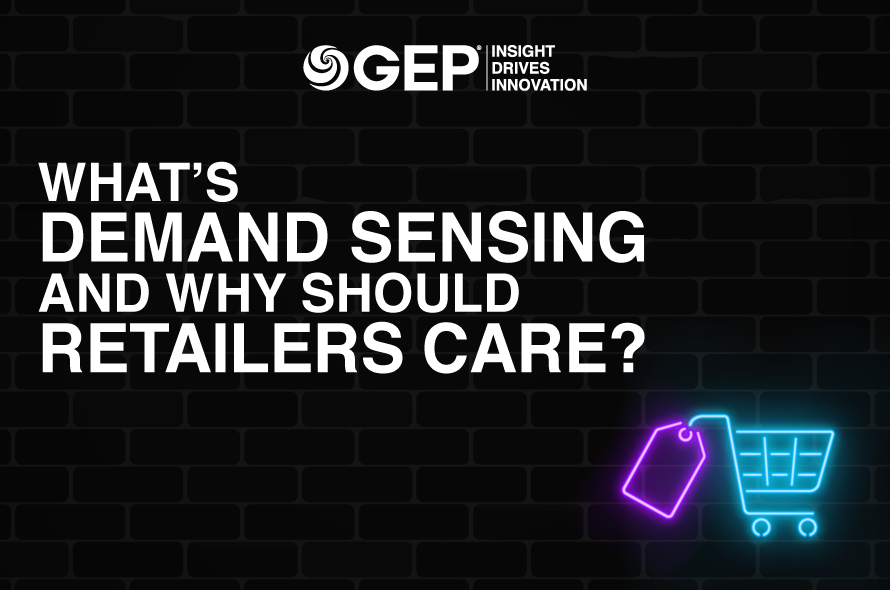One big lesson from the pandemic: Retail supply chains built for brick-and-mortar fulfillment failed miserably in an increasingly omnichannel world. Online sales skyrocketed, messing with traditional demand signals that focus heavily on in-store sales and inventory.
A new GEP bulletin — What’s Demand Sensing and Why Should Retailers Care? — shares how retailers like Target are deploying demand sensing tools to reduce out-of-stocks and keep customers happy. Leaders are leveraging AI-powered solutions to optimize capacity and boost planning accuracy.
What’s Inside:
- Why forecasting tools and legacy systems missed the mark
- Setting clear demand sensing goals to achieve ROI
- Preparing to meet pent-up demand after COVID
The increasingly online consumer
Customers now have more choices than ever — from locally owned boutiques to retail giants — and they choose products from any size ‘store’ that meets their needs the best. Consumer decisions depend on convenience, speed, cost of delivery, brand loyalty, social status, product price, environmental considerations, and much more. Demand sensing is the ability to collect clearer and more accurate demand signals from AI-powered digital technologies to optimize capacity and supply chain planning — and it has never been more important to retailers.
In recent years, the percentage of retail purchases made online has hovered between 14% to 15%. In 2020, this rose sharply to 21.3%, largely due to COVID-19 and government restrictions to remain at home.1 This was a welcome boost for many retailers who have increasingly developed omnichannel retail models to reach more customers, improve fulfillment and enhance the overall customer experience. Retailers who successfully incorporate customer engagement into their omnichannel strategies are enjoying customer retention rates as high as 89%, compared with their peers who are hovering around 33%.2
The globalization of many retail brands creates an additional layer of complexity for supply chains. Customers and suppliers are spread far and wide, so retailers must do more than just ‘win’ the customer from their competitors. They must monitor and navigate supply challenges arising from political instability, severe weather, global pandemics, driver shortages, fuel price instability, and much more to effectively manage their supply chains and deliver products into their customers’ hands.
Retailers face several priorities that are at odds with one another. Supply chains are designed for speed and efficiency yet need to be ’agile‘ enough to handle supply shocks and ensure quick and accurate order fulfilment. Inventory and its associated costs must be kept to a minimum, but sales should not be missed. If that isn’t enough to keep you up at night, all of this happens within the context of a hyper-connected world where the media can publish a story that devastates your brand’s reputation or a social media platform such as TikTok can catapult your brand to stardom overnight.
Modern day challenges and complexities require sophisticated technologies that enable retailers to take a proactive approach to demand planning. Shopping behaviors have changed dramatically over the past few decades while forecasting technologies and procedures haven’t kept pace. However, companies now have the option to implement demand sensing, a solution that rises to the challenge of today’s increasingly complex landscape.
What is demand sensing?
Demand sensing is a software solution that leverages the latest technologies such as artificial intelligence, machine learning, real-time data, etc., to close the gap between your demand planning and what is happening in your supply chain. How does it work?
- Algorithms sift through incredible amounts of metadata to determine which ones currently have the strongest impact on demand.
- Demand sensing constantly monitors real-time, downstream data (such as Channel Data) to provide warnings when your channel partners are running low on inventory for specific items.
- Demand sensing can create forecasts that consider the impact of real-world events such as hurricanes, heavy snowstorms, economic downturns, shifts in consumer preferences, and even relevant social media trends.
- Demand sensing monitors where your inventory is within your supply chain. As you become aware of actionable demand signals, it equips you with the knowledge you need to optimally deploy that inventory to capture sales.
How is demand sensing different?
Traditional approaches to forecasting demand lack crucial external data that can provide a near real-time view of demand and what influences it.
Companies using legacy, traditional approaches tend to aggregate forecasts that only consider past trends or simplistic projections of future needs. While these approaches may seem highly accurate (e.g., 90% accuracy), the reality is that they miss substantial possible sales at the item-location level while also overspending on inventory costs.
Demand sensing improves forecasts, profit margins and sustainability
The benefits of demand sensing are clear, and provide a competitive edge to the CPO and CSCO including:
- Picking up on short-term trends immediately and deciding whether to act on them
- Improving on-shelf availability and capturing more sales
- Better understanding the efficacy of your promotions and new product launches
- Sustaining competitive advantage over peers who are using more manual, less accurate processes
- Supporting sustainability goals by avoiding waste incurred by incorrect forecasts
The benefits are measurable and proven. For instance, Martinus, a major East European omnichannel e-commerce bookstore, increased their product expedited on the day of placed order by 84% and improved its average order fulfillment time by 14%.3 Also, when Target began using these technologies several years ago, it was able to decrease out-of-stock levels by 40% in one of its stores that was being used as a test case.4
There is a benefit and ROI from implementing a demand sensing solution as long as the end goal is clearly identified, such as reducing stock-outs, lowering inventory or improving supply and demand mismatches. Like with most software, a simple implementation by itself is not a panacea — the organization should have a supporting process and a mandate to ensure use and adoption of the solution.
The future of demand sensing in retail
As some countries begin to emerge from the impacts of COVID-19, retailers can anticipate pent-up demand in certain categories such as cosmetics and clothing. For many retail companies, COVID-19 highlighted the risks within their supply chains, and they will be evaluating demand sensing technologies with renewed interest.
Companies are already prioritizing the full digitalization of their entire supply chains. Gartner predicts that “by 2023, at least 50% of large global companies will be using artificial intelligence, advanced analytics and the internet of things in supply-chain operations.”5
Companies that implement demand sensing now will be able to derive a sustainable competitive edge, especially as they will be free to focus on the next element of supply chain digitalization.
References
- Fareeha Ali, “U.S. Ecommerce Grows 44% in 2020,” Digital Commerce 360, 29 January 2021 | https://www.digitalcommerce360.com/article/us-ecommerce-sales/
- Ibid.
- Cem Dilmegani, “Demand Forecasting in the Age of AI & Machine Learning [2021],” AIMulitple, 7 January 2021 | https://research.aimultiple.com/demand-forecasting/
- Roberto Torres, “Target Leans on Data Science to Solve 'Extremely Large' Retail Problems,”CIO Dive, 18 December 2019 | https://www.ciodive.com/news/target-leans-on-data-science-to-solve-extremely-large-retail-problems/569198/
- Gartner, “Gartner Identifies Three Trends That Will Impact the Future of Supply Chain,” Gartner Press Release, 8 October 2020 | https://www.gartner.com/en/newsroom/press-releases/2020-10-08-gartner-identifies-three-trends-that-will-impact-the-future-of-supply-chain

